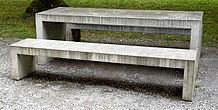Rigid corner

car - beam axle ; wheel-bearing swing arm welded together with crossbeams; Widened beam end to improve flexural strength in the corner area
As a rigid corner (also flexurally rigid Eck , rigid corner connection , rigid corner profile ) is used in the structural analysis , the connection of two rods or plates designated forming a corner, but not rotationally movable like a joint , (s. Opposite). The connection is rigid and can - unlike a joint - transmit a torque ( bending moment ).
For trusses , corner connections (nodes) need i. d. As a rule, no bending-causing torques should be transmitted.
The term corner stiffness is common in mechanical engineering in general and primarily in the automotive industry . It is generally used to express that component connections that form corners are designed to be particularly rigid thanks to additional structural measures ( haunch , bracing, etc.). There is no demarcation from the joint - as with a rigid corner in structural engineering.
Comparison between a rigid corner and a rigid beam
The assessment of a corner in a component as rigid in structural engineering differs fundamentally from the z. B. for a beam often used parameter bending stiffness . The rigidity of a beam is a quantitative quantity, while the rigid corner is used as a qualitative term. The bending stiffness of a beam has a certain value that is calculated from the product (with the modulus of elasticity and the area moment of inertia at the interface under consideration).
Application of the beam theory
In rod theory, the relative rotation angle at the intersection of the two rod axes is zero. This means that the bar chord angle between two bar axes at the point of intersection is constant.
symbol
A rigid corner can enclose any angle and is often represented with a triangle painted in black.
Design of rigid connections
- Concrete construction : When a component is concreted in a concreting and is appropriately reinforced (e.g. in reinforced concrete construction ).
- Concrete construction: At construction joints when concrete is being poured wet on wet or rough on rough and the reinforcement is anchored continuously and on both sides.
- Steel construction and aluminum construction: riveted , screwed and welded connections.
- Steel construction: For non-slip pre-tensioned screws that are present several times (GV connection).
Corner roundings and material additions
A corner “made from one piece” generally has the same strength as the adjacent bars, but locally increased stresses occur due to the notch effect at the inner corner. These are reduced by rounding. However, this is a local question of strength and not of stiffness. In the case of material additions that are extended into the two rods, the flexural strength outside the corner area is also increased.
References and comments
- ↑ a b Wolfgang Matschinsky: Wheel guides of road vehicles: Kinematics, Elasto-Kinematik and construction , 3rd edition, Springer Verlag Berlin Heidelberg 2007, ISBN 978-3-540-71196-4 , section on twist beam axles
- ↑ a b Löbel, Gerhart: Large bending deformations in slim straight and circular beams . In: Wiley Online Library (Ed.): ZAMM-Journal of Applied Mathematics and Mechanics / Journal for Applied Mathematics and Mechanics . tape 43 , no. 1-2 , 1963, pp. 25-46 , doi : 10.1002 / zamm.19630430104 .
- ↑ Franke, Wolfram, and Thorsten Kunow: Small basics of structural engineering: Things worth knowing for new and re-learners . kassel university press GmbH, 2007 ( books.google.at ).
- ↑ Trautz, Martin and Koj, Christoph: Reinforcing with screws . In: Wiley Online Library (Ed.): Bautechnik . tape 85 , no. 3 , 2008, p. 190–196 , doi : 10.1002 / bate.200810016 .
- ↑ Theoretically, the truss nodes can be treated as rotatable corner connections or joints in a first approximation, because i. d. Usually only negligible bending moments occurring in connection with “relatively small secondary stresses” can be transmitted and can also be transmitted without interference (cf. Fritz Stüssi : Baustatik I , Birkhäuser Verlag , 1971, page 116.)
- ^ Heinrich Dubbel, G. Glage, W Gruhl, R. Hänchen, O. Heinrich, M. Krause, E. Toussaint, H. Winker, K. Woters: DUBBEL - paperback for mechanical engineering . Ed .: Heinrich Dubbel. 1st edition. Springer, Berlin 1914, ISBN 978-3-642-64910-3 , doi : 10.1007 / 978-642-64925-7 ( google.ch ).
- ↑ Rinke, Mario and Kotnik, Toni: The unleashed building material . In: Wiley Online Library (Ed.): Concrete and reinforced concrete construction . tape 107 , no. 9 , 2012, p. 635–644 , doi : 10.1002 / best.201200031 .
- ↑ Beer, Klaus: Reinforcement according to DIN 1045-1 . Ed .: Springer. 2007, 6 base plates, doi : 10.1007 / 978-3-8351-9113-6_6 .






